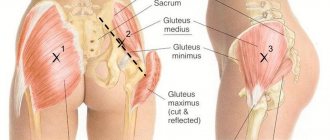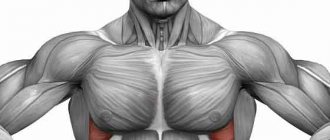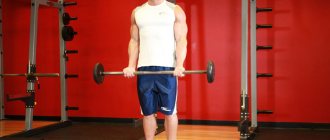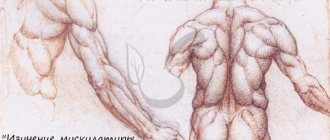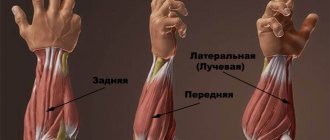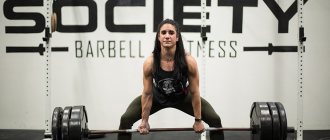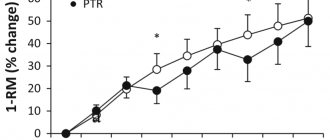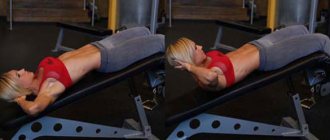The ability to abstract
Abstraction (from Latin abstractio - distraction) is the ability to not pay attention to factors distracting from the main activity. In other words, it is the ability to focus (concentrate) on the right things.
I brought this concept up not by chance. In the gym (and in life in general) we are surrounded by many distractions. These include girls gracefully performing various exercises, loud music, other athletes who for some reason glance in your direction, so maximum mental concentration is very important here!
You need to be able to feel your muscles in order to understand exactly how you need to apply this or that effort. Typically, those muscles that an athlete has learned to contract competently when performing exercises always look more developed and aesthetically pleasing.
For example, a professional bodybuilder can load a muscle much more with less weight than a beginner can by lifting excessive weights. Where is the dog's secret buried?
A very common mistake of beginners is that when they have not yet learned the correct technique for performing exercises, as well as the correct contraction of their muscle fibers, they begin to work with weights that are very heavy for their level of training.
They cannot properly concentrate on how the loaded muscle or muscle group works, because... They are busy trying not to screw themselves, by any means necessary, to lift unbearable weights, using cheating or crooked techniques.
Iron Health
For a long time, it has been fashionable among bodybuilders to use the so-called principle of “shocking” muscles. Some athletes actively use this approach today, conveying misconceptions about its benefits to beginners. In reality, there is no such thing as “shocking” when applied to muscles. Why? Let's figure it out.
Muscle shocking: the basic idea
When you regularly perform the same exercises, the muscles, like the body, adapt to this load. As a result, habitual workouts do not cause pain in the muscles and are performed much easier than at the initial stage. Worst of all, these adaptations slow down strength and mass gains.
To avoid this, they suggest using the so-called “shocking” of the muscles, that is, constantly changing training programs - both the order of exercises and the exercises themselves. Moreover, the more non-standard the program turns out to be, the more it “shocks” the muscles.
In fact, this theory seems very logical, because constantly using the same exercises with the same weight will inevitably lead to stagnation in the growth of strength and muscle mass. However, the principle of “shocking” is not able to solve this problem.
Muscle Shocking: Debunking the Myth
Let's start with the fact that muscles cannot think, much less be surprised and shocked. They, in a general sense, perform only two primitive mechanical functions - contraction and extension. Through what exercises this happens is absolutely not important. What matters is what kind of stress they experience.
One of the main conditions for muscle growth is intense physical activity - the more intense it is (within reasonable limits), the larger the muscle growth it causes. Well, an increase in muscle mass also leads to an increase in strength indicators. That is why another important factor in muscle growth is the so-called “overload principle,” that is, a regular progressive increase in load (working weight). Simply put, each subsequent workout of a specific muscle should be slightly more intense than the previous one (achieved by a slight increase in working weight or a reduction in rest time). This process will cause a number of adaptive reactions, the result of which will be an increase in the strength and mass of the athlete. That is why it is recommended to add at least 1 kg to the working weight at each workout or do at least one extra repetition with a critical weight. “Shocking” muscles is not a way to increase the intensity of a workout, but is only a way to diversify the exercises, which has virtually no effect on either strength or muscle mass. Yes, new exercises or a different order of doing them will be harder for you, but all this only increases the relative intensity of the workout. For example, imagine a newcomer to the gym who comes to his first workout - any, even the simplest and easiest exercises will be super intense, complex and difficult for him, but they will not cause a powerful impulse to increase strength and muscle mass. Precisely because these workouts are super-intense only relative to his unprepared level, at which the muscles simply do not yet know how to show their full strength potential in movements that are new to him. But over time, the muscles will “learn” to overcome such a load without spending a lot of energy on coordination and control of technique, after which the working weights will increase significantly (and will continue to grow) even though muscle mass will remain at the same low level. And only such a load will have a powerful stimulating effect on the mechanism of muscle growth.
Thus, “shocking” muscles is one of the ineffective bodybuilding techniques that does not have any effect on the growth of strength and muscle mass of the athlete. In addition, the principle of “shocking” the muscles once again proves that subjective sensations during training or after its completion cannot be a guideline or some kind of indicator of effectiveness.
How to swing correctly
You need to focus and think about the muscle you are working. Any movement in our body begins with the brain, or rather with electrical impulses that it communicates, through the nervous system, to our muscles.
Think about how your muscle fibers contract, how a muscle contracts and increases in volume, and in general about which muscle works when performing this exercise. It’s better to take a little less weight, but contract the muscles correctly! So that they cramp from exhaustion during peak contraction.
The greatest bodybuilder, the famous Arnold Schwarzenegger, or as he was called the “Austrian Oak,” when he worked out in the gym, with each approach, he imagined that his muscles were swelling so much that they were about to fill the entire gym!
Advice:
You need to think that you have already scored a goal before you hit the ball. Visualize the image you are striving for.
Kegel muscles: where are they and how to develop them
In 1948, gynecologist Arnold Kegel, frustrated by the ineffectiveness of surgery to treat urinary incontinence in women, spoke for the first time in the history of modern medicine about the importance of non-surgical strengthening of the pelvic floor muscles. “Kegel muscles,” as they are now often called, support the uterus, bladder, rectum and small intestine—an important part of the anatomy, to say the least.
The tone of the pelvic floor muscles is reduced:
- time (these muscles, like any other, weaken with age);
- pregnancy and childbirth;
- abdominal surgery, including caesarean section;
- obesity.
Kegel exercises will help in the following cases:
- Stress incontinence (for example, while coughing, sneezing, running, or lifting heavy objects);
- urgent incontinence - when the desire to empty the bladder is so strong that you do not have time to run to the toilet (do not confuse it with incontinence due to bladder overflow, here exercises are powerless);
- weakening of the pelvic floor muscles after childbirth, which can, in addition to the symptoms above, cause prolapse of one of the pelvic organs, such as the uterus.
FAQ
How to feel the right muscles?
Try stopping the stream when urinating. If it works, congratulations, you have found the Kegel muscles.
And if not?
Perhaps you just want to go to the toilet too much to hold back (if not, this is a pretty alarming sign, run to the gynecologist). As an alternative, try inserting a clean finger into your vagina and squeezing. If everything is in order, you will feel a lifting of the pelvic floor.
That's all?
Well, if you’re not interested in that, take it for a test drive with your loved one: during sex, try squeezing his penis inside you and ask if he feels like you’re gripping him tighter.
Do I need to do exercises specifically when urinating?
No. On the contrary, it is contraindicated and may aggravate symptoms or even cause pain.
How to prepare for exercise?
Empty your bladder and you're good to go.
Are there other nuances?
You know how when you bend your index finger, the rest also bend slightly? So, with Kegel exercises, a similar thing happens: your gluteal muscles and abdominal muscles can automatically tighten. Try to control this moment. When the pelvic floor muscles are tense, the rest should ideally be relaxed: this way you will avoid overexertion and spasms.
How to train?
Take a comfortable position: sitting, lying or standing (but not while walking). Tighten the desired muscles as hard as possible for 5 seconds, then relax. After a short pause, repeat. Do 10 of these approaches. Don't forget to breathe, otherwise you will get tired faster and the benefits of your workout will decrease.
How long and how often should you train?
Research shows that you can feel the first effect after 4-6 weeks of regular training two or more times a day.
The million dollar question: will my orgasm get stronger?
Quite possible. Unfortunately, there are no studies confirming this beyond a shadow of a doubt (there is a problem with the study of female orgasm in general), but many participants in surveys on the effectiveness of Kegel exercises claim that the duration and intensity of their orgasms have increased. This is easy to believe, because training the pelvic floor muscles accelerates the flow of blood to the perineum, particularly during arousal. It definitely won't hurt your orgasm. In addition, you will please your man with a narrower and tighter vagina. Win-win, as they say.
Little Helpers
In addition to the “analog” way to develop Kegel muscles, you can include special weight balls in your workout, which will make the exercises more difficult and more effective. There is a large selection, for example:
Balloons have only one problem - the lack of feedback: it’s hard to maintain motivation if there is no clear result.
Arnold Kegel himself used a bulky device made of a rubber bladder and tubes in the forties to measure muscle strength during exercise. Now that interest in the topic is finally on the rise, several modern and very nice analogues have appeared.
A review of one of these devices will appear on Lifehacker soon. Which one do you think? Would you buy such a thing for yourself? Tell us, have you done pelvic floor muscle training and what results have you achieved?
Technique No. 1: Rest-pause
When professional Nasser El Sonbati feels that the babies are “asleep”, he goes... to rest. However, if you think that Nasser is relaxing, lying down with glasses of lemonade near his pool, then you are sorely mistaken.
In fact, we are talking about the “rest-pause” method, Nasser explains. - Let's say I do bench presses with a barbell on an incline bench. First, I perform eight to ten repetitions, achieve failure and return the bar to the racks. I wait six to ten seconds, take the bar down again and do a few more reps. And again a pause, several repetitions (as far as strength is enough), but this is the last time.
Believe me, “rest-pause” is a very effective technique, Nasser convinces.
By the end of the set, my chest felt like it was on fire. I use this method for different purposes. At the stage of pre-competition preparation, in combination with a “hard” diet, it gives a very good “separation” of the pectoral muscles. In the off-season, I use it every two workouts to the third. But here the task is completely different - mass growth.
“Rest - pause” is not a technique for beginners. But even experienced athletes need outside help.
Don’t forget that “rest-pause” is based on constant “failures,” Nasser reminds, “which means the barbell can collapse on your chest at any moment. Someone has to back you up, right?
What happens during muscle growth.
Muscles respond to stress by growing. When microcracks heal, each damaged fiber becomes thicker and stronger in order to continue to cope with such a load.
The number of fibers in a muscle can vary. Once as a child, after watching one program on TV, I decided that the number of muscle fibers is always the same, only their strength and thickness changes. It turns out that when adapting to a new load, new fibers can grow.
Your muscles also become thicker due to the storage of various substances in them. For example, glycogen and creatine phosphate.
The larger the muscle, the more it can store these substances in itself. It is believed that pumping (pumping) during training allows you to increase the space for storing nutrients, thereby increasing muscle volume.
Change the exercises
There are a huge number of exercises designed to train different muscles. Everyone usually chooses those that are more comfortable for him to perform, leaving all the rest without attention.
It is not right. Experienced trainers recommend having at least a couple of training programs that need to be changed from time to time. By following the recommendations outlined, it is much easier to overcome “stagnation” and quickly achieve results without physical and moral losses.
Let's say you learned how to bench press correctly and reached your maximum weights. Or I gained a lot of weight after a visit to my grandmother (I gained muscle, not fat). In any business, sooner or later you will face stagnation.
The working weights will stand like the Germans at Stalingrad. If this is the case, then you definitely need to use non-standard approaches. Don’t stab yourself in the ass, don’t understand what, but USE NON-STANDARD APPROACHES, don’t get confused. A good option is to shock the muscles.
There are a lot of training programs using additional elements. , pumping, etc. You've definitely tried them all. But what if the weight still doesn't increase? In this case, try to throw in even more repetitions and proportionally reduce the weight. This is done to isolate the muscles, and not because you are skinny. It’s better to kill your biceps with 10-kilos and hold your elbows correctly than to take 16 kg and pull with your back, simultaneously throwing your hands behind your ears.
Even more isolation!
The high repetition technique is, by and large, suitable for any muscle. For better isolation, exercise equipment is a good choice. Here's an example for you. You need to make a large quantity. It doesn't sound bad, but in practice you'll die halfway through. Moreover, not because of the engorged quadriceps, but because of general fatigue, since you use a huge muscle layer to maintain balance and much more. Now replace the usual squat with Smith or Hack (whoever you like better). The target muscles will work here and the maximum effect will be obtained by removing the load from other muscles.
What is the ability to relax
Often people forget how important it is to give yourself rest.
The ability to relax physically and emotionally is a useful function of the body, which can be forgotten over time. Especially if you have been under constant stress and conflict for a long time. Internal problems cannot find a way out if you do not know how to relieve tension without resorting to the help of a psychologist. Nevertheless, there are such ways, and there are many of them. It’s enough to find a suitable option for yourself and remember to use it from time to time.
The ability to abstract yourself from unpleasant surroundings and thoughts is the ability to relax. You can do this almost anywhere where you can retire for a few minutes. Failures, problems and other negativity will gradually recede from you.
Nutrition for growth
Both men and women should take into account that no matter how much you “surprise” your muscles, without proper nutrition they will not grow. After all, in this case, they will have nowhere to get building material - protein. And for high-intensity training, energy is needed - carbohydrates.
Therefore, the result of your training directly depends on what you eat. And we smoothly move on to nutritional advice.
Follow these steps and growth will follow.
- The calorie content of your diet should be excess, but only by 700-900 kcal for men and 200-400 kcal for women. Women need to know that when you have a calorie surplus, you store fat faster, so your calorie surplus should be negligible.
- Consume only high-quality and healthy food. For protein, give preference to lean meats, as well as milk and eggs. Try to consume slow carbohydrates (cereals, vegetables and unsweetened fruits). First-class sources of fats are: red fish, seafood, nuts, avocados, various oils (sunflower, olive, flaxseed)
- As a rule, after 40 years, the production of testosterone (the main male hormone) decreases, and its amount directly affects muscle growth. Therefore, at this age you need to increase the amount of foods that increase testosterone levels in your diet. These can be lean meats, seafood, greens, vegetables (possibly spicy) and nuts
In addition to such important components as nutrition and training, muscle growth can be promoted. But their choice must be approached with full responsibility. Despite the fact that they do not have serious side effects, they should be taken wisely and it is best to consult a doctor before use.
These drugs include:
- Vitamins and vitamin-like substances (vitamin-mineral complexes, B vitamins)
- Anabolizers (glutamic acid, methionine, potassium orotate, )
- Enzymes (festal, karsil)
- Energy drugs (inosine, lipoic acid, )
- Performance enhancing agents (ginseng root, eleutherococcus)
- Drugs affecting the central nervous system (nootropil, aminalon)
- Drugs affecting blood properties and blood flow (trental, complamin)
Please pay close attention to the following instructions. These drugs should be taken only after consultation with a doctor (preferably a sports doctor) and under his supervision. Also, beginners, that is, people whose training experience does not exceed 2 years, do not need to take these funds!
Physiology of muscle growth
Why do muscles grow? We have already discussed how to stimulate muscles to grow, now let’s talk about what remains behind the scenes, about what happens inside our body.
The process of muscle hypertrophy (growth) begins with an unusual load, i.e. you are stepping out of your comfort zone. You haven’t run before, but today you ran 5 km at once. Your muscles received a load higher than usual and you sent a signal to the body - grow, adapt to the load. But if this load is not repeated in the near future, then the rollback process begins and your muscles return to their original state, as if you had never trained.
The body is essentially very lazy and does not want to do anything until you force it! He always tries to get rid of what he doesn't use. Let you gain 10 kg of pure muscle mass through training, but if after some time (for example, a year) the body does not receive loads, your muscles will simply deflate! The body will eat them! He believes that since you don't use muscles, you don't need them.
This is called the catabolic process or the breakdown of muscle tissue. This is the reverse process of anabolic growth of muscle tissue.
There is an interesting pattern - the body willingly burns muscle, but is in no hurry to increase muscle mass. Therefore, after the first workout, even if your muscles hurt, do not expect that these actions are enough for noticeable muscle growth
.
To stimulate muscles to grow,
you need to constantly stimulate them, give them regular, ever-increasing loads! Only then will your muscles begin to grow.
If there is no regularity of load, then, as you already know, a rollback begins and you return to the starting point. You shouldn’t be offended by your body and say that it doesn’t allow you to be big and strong. On the contrary, knowing these mechanisms, you will be able to consciously control your body and muscle growth!
Learning to feel the muscles
To get the most out of your training and achieve that desired muscle growth, it is important not only to concentrate on the weight of the barbell, but also the psychological side of perception. You need to learn to feel the work of a muscle, not only understand the mechanism of its contraction; this factor is very important for the correct concentration of nervous energy in the muscle.
Ability to concentrate on exercise
When you come to the gym for training, there are a lot of distractions waiting for you. Each of them wastes your energy, which could be spent directly on muscle contraction. Oddly enough, psychological concentration during training is no less important than the training itself. By concentrating on the work of your muscles, you get more out of your workouts, due to the fact that your energy is directed in the right direction.
In addition, a common mistake athletes make is focusing on the weight; they choose heavy weights, and their only goal is to overcome it. This is not correct; experienced athletes can exercise with minimal weight and still achieve more significant results. The power of imagination helps them in this, directing all the energy into the working muscle.
It is very important to understand this psychological aspect at the beginning of your studies. The ability to feel muscle contraction will lead you to the uniform development of all their main groups. As a rule, muscles that a bodybuilder feels well grow faster than others and look more impressive. To achieve uniform growth, you need to approach this issue from a psychological point of view, learning to feel absolutely all the main muscles.
How to achieve the required concentration?
The first thing you need to learn to do is to abstract yourself from your surroundings. There are you, and there are your muscles, which grow thanks to your efforts. While performing the exercise, imagine how your muscle works and grows, how its fibers contract, how it contracts and unclenches.
To completely abstract yourself, you can use the Arnold Schwarzenegger method. During the exercise, he closed his eyes and imagined his biceps in the form of balloons or mountains that fill the entire space of the gym.
And one more tip on how you can learn to concentrate on the work of your muscles is imaginary training. Before going to bed, close your eyes and mentally imagine that you are in the gym and do imaginary exercises without weight for 15 minutes, but at the same time forcefully contract your muscles, as if you had a lot of weight in your hands at that moment.
Muscle contraction and relaxation
The mechanism of muscle contraction and relaxation is still not fully understood. But it is known for sure that ATP molecules act on this process. The process is triggered by an increased concentration of ions resulting from the appearance of a nerve impulse.
There are many hypotheses regarding this process; one of the main ones is the theory of “sliding threads”. Its essence is as follows: muscles consist of thick and thin fibers; when the muscle is at rest, they are corroded, but at the time of their work, a transverse bridge is formed that connects them. At this moment, the ATP activity of myosin increases, leading to the sliding of muscle filaments towards each other. After this process, ATP activity drops sharply and the so-called bridge breaks. The subsequent arrival of a nerve impulse again causes the appearance of a transverse bridge and the whole process is repeated.
Natural bodybuilding training program or start for a beginner
The best muscle growth occurs at the beginning of training; when starting bodybuilding, it is very important not to miss this time. Therefore, even without taking any medications, with a properly designed training program, it will be easier for a beginner to achieve muscle growth than for an already experienced athlete, but this will happen in the future. Why is this happening? A new bodybuilder does not have muscle adaptation to strength work, which leads to more stress on the muscles and, accordingly, more destruction. In all other aspects, the beginner’s body is not yet ready; the following points are needed:
- develop a technique so that the load is applied precisely to the necessary muscle groups, and not to joints and secondary muscles;
- psychological attitude mentioned above. That is, the formation of a connection between the brain and muscles;
- adaptation of the energy, bone-ligamentous and circulatory systems.
Based on this, natural bodybuilding must be consistent. The main task for a new bodybuilder is to prepare his body for muscle growth in the future, and not to tune in to the growth of muscle fibers at the moment.
The training program should be based on the following principles:
- training with the minimum weight;
- maximum volume of exercises, from 12 to 25 repetitions in each approach, which should be at least 5-10;
- training should concern all muscle groups without exception;
- The optimal frequency of classes in the gym is 3 times a week;
- concentrate on the muscles, think about their contraction and relaxation;
- thoroughly master the basic exercises.
In natural bodybuilding, two main aspects are important - technique and psychological concentration. By performing the exercises correctly, scrupulously observing the nuances and thinking about how your muscles work and grow, you will certainly achieve the desired result!
Share on social media networks
RќСЂР°РІРёС‚СЃСЏ
| Add rating |
Categories Bodybuilding
Technique #4: One more time
“I start my chest training like everyone else with a warm-up,” says amateur Mike Dragna, “then there are five different exercises of two sets, for a total of -10. The exercises are: barbell and dumbbell presses on an incline bench, fly-ups...
In general, nothing fundamentally new. Another thing is that in each exercise I do two to three forced repetitions with the help of a partner.
The most important thing, Mike believes, is to achieve true muscle “failure.” That “rejection” that comes at the end of the set is often “fake.” It is more likely to be caused by psychological fatigue than muscle fatigue. Next, you need to “finish off” the muscle to “correct” failure through forced repetitions. It is extremely important to find a skillful partner who will be able to share the load with you without “taking away” a single “extra” kilogram from you.
I use a relatively heavy weight, says Mike, and it lasts me a maximum of six to eight repetitions. Then the partner comes into play. Forced repetitions begin and pain appears. Forced reps are a blast! They greatly stimulate the growth of the “mass”. At least for me.
